How To Use Wordpress For Website
Trying to find out how to create an eCommerce website with WordPress?
While WordPress originally started as a blogging tool, it's long since morphed into a powerful website edifice tool that's capable of creating whatever type of eCommerce store.
In fact, WordPress is the virtually popular manner to brand an eCommerce shop — even more popular than Shopify.
In this tutorial, we're going to cover all of the information that y'all need to add your shop to the ranks of the nearly pop eCommerce tool on the Cyberspace.
And, hither's my promise:
Y'all'll be able to fully gear up your store without ever looking at a unmarried line of code. By the stop, you'll have a fully functioning WordPress eCommerce store that looks something similar this:

Permit'south dig in!
How Does eCommerce Piece of work on WordPress?
Below, we're going to become through a detailed tutorial on how to create an eCommerce website with WordPress.
Nonetheless, before digging into the gory details, I think information technology's useful to take a high-level look at what information technology's like to use WordPress for eCommerce. That style, you'll have the full context before digging into the tutorial.
So — permit'southward get-go at the beginning.
If you've already built a WordPress site before, yous've probably noticed that the core WordPress software does not include any eCommerce features.
Withal, as is e'er the case, you tin can add total eCommerce functionality using a plugin. Most of the time, that plugin is WooCommerce, though in that location are some other options that I'll talk over in a 2nd.
Then to create the foundations of your eCommerce store, the starting point looks like this:
- Yous gear up up your basic WordPress site if you lot haven't done so already.
- You install a WordPress eCommerce plugin such as WooCommerce.
Once you have that eCommerce foundation, you'll build out your store just like any other WordPress site:
- To command the design, you lot'll install a WordPress theme that is compatible with WooCommerce (or your called eCommerce plugin) — for instance, the Botiga theme.
- You'll dig into WooCommerce's many settings to control fundamental details such every bit payments, shipping, taxes, and more.
- You'll install additional WordPress plugins to extend your shop with new features.
Don't worry; I'chiliad going to cover all of that in this tutorial, so this volition brand more than sense in a second.
Which Is the Best WordPress eCommerce Plugin?
When talking about eCommerce on WordPress, the default expectation is almost e'er that y'all're going to use the WooCommerce plugin.
WooCommerce isn't just the most popular WordPress eCommerce plugin by a large margin, but it's as well the nearly popular way to make an eCommerce store — even more popular than Shopify if y'all expect at BuiltWith's peak one one thousand thousand sites index.
For that reason, I'm going to apply WooCommerce in the tutorial below.
However, WooCommerce is not the only viable WordPress eCommerce plugin, so allow's run over a few of the other quality options and when you might want to employ them:
- Easy Digital Downloads (EDD) – This 1 tin can be a adept option if you're specifically selling digital files rather than concrete products. While WooCommerce can also handle digital files, EDD'southward singular focus creates a more streamlined experience.
- BigCommerce – BigCommerce is a SaaS eCommerce tool that integrates very deeply with WordPress to create a sort of "headless eCommerce" approach. This is more than advanced, merely it gives you a lot of flexibility. The primary reason to consider BigCommerce over WooCommerce is if you lot're engaging in multi-platform selling, i.e. you're likewise selling via Amazon, eBay, and other platforms. With BigCommerce, you can sync all of your different sales channels in one spot, which adds a lot of convenience.
- Ecwid – Ecwid is another SaaS eCommerce tool that integrates with WordPress thanks to a dedicated plugin. It tin can be a good option for beginners with very bones stores because of its simple approach, but I don't actually recommend it for serious stores as it's not most as flexible and powerful as WooCommerce.
With that being said, WooCommerce is still the best eCommerce plugin for the vast majority of online stores.
Unless y'all have a very specific and well-thought-out reason for choosing a different WordPress eCommerce plugin, I highly recommend yous stick with WooCommerce.
WordPress eCommerce FAQs
Now, let's quickly run over a few FAQs so that you lot know what to wait from this tutorial, as well as WordPress eCommerce in full general.
How Much Does a WordPress eCommerce Store Cost?
WordPress and WooCommerce are both 100% free. However, in that location are a few associated costs for your store.
At a bones level, you lot'll demand web hosting and a domain name if you lot don't already have a WordPress site. If you've already set your site, you tin use your existing hosting. Only if you haven't yet, upkeep at to the lowest degree $ten per month for a small store and more for a store with high traffic and/or lots of products.
Beyond that, you'll almost certainly want to purchase some premium tools to add to the core WooCommerce plugin.
First, you might want a premium WooCommerce theme, which will price you lot about $60 (though there are likewise quality free WooCommerce themes).
2nd, you might also want some premium WooCommerce extension plugins, which is the biggest price area for almost stores.
Unfortunately, there'south way also much variability to give a unmarried number hither. Some stores might only spend $100 on plugins, while others might spend $1,000+. If you're on a tight budget, you can usually notice ways to go along your WooCommerce plugin costs downwardly, though.
Practise I Need to Be a Developer to Create a WordPress eCommerce Store?
No, you don't need whatever special technical knowledge to follow this tutorial and set up up your eCommerce store. You tin practise pretty much everything from the user interface; there's no need to always look at a line of code.
There are more settings than on your boilerplate WordPress site considering you lot'll need to configure details such equally shipping, taxes, and payment gateways. But, all this takes is some extra time — it doesn't require whatsoever special technical knowledge.
How Long Does It Take to Create a WordPress eCommerce Store?
The bones process of creating your store'south foundation takes very little time. You lot can have a fairly functioning eCommerce store in well nether an hour (fifty-fifty less if you already have an existing WordPress site).
However, that doesn't mean you'll be finished in under an 60 minutes. You lot'll spend well-nigh of your time configuring the nitty-gritty details of your store, such as:
- Shipping rates and policies
- Tax rates
- Adding products
- Payment gateways
- Etc.
None of these tasks are complex, merely it will have you lot some time to work through the details, especially if you want to do things manually rather than using a plugin to assist out (which might cost coin in some cases).
The nice thing, though, is that most of these tasks are one-time things. For example, once yous set up your shipping rates, your store will automatically use them without requiring farther input from you.
Is a WordPress eCommerce Store Secure?
Yes, as long as you lot're using secure hosting and following WordPress security best practices, your store is totally secure.
Additionally, your store's credit card payments will be processed by a third-political party gateway such every bit PayPal or Stripe, so you won't need to deal with the stress of secure payment processing and PCI compliance. The third-party processor is fully responsible for all of that.
Can a WordPress eCommerce Shop Load Fast?
Yes, absolutely. Once more, the cardinal detail here is that your store volition load fast as long as you lot're post-obit WordPress operation best practices, such as using a fast WooCommerce theme and optimizing your content.
Afterwards in this tutorial, nosotros'll accept a whole section dedicated to showing you how to make your shop load fast. As with the residue of the tutorial, this won't require any special knowledge.
How to Create an eCommerce Website with WordPress
Now that you have a good idea of how WordPress eCommerce works, let'southward dig into the total footstep-by-pace tutorial.
This guide will take yous from "zero" to a fully performance eCommerce store powered past WordPress.
one. Gear up Your WordPress Site (If You lot Don't Have One Already)
If yous already have a basic WordPress site, you can click here to skip alee to the next section to learn how to add eCommerce functionality to that site.
Notwithstanding, if you don't accept a WordPress site still, you'll need to set up i before you can turn information technology into a fully functioning eCommerce store.
To exercise that, you'll need to do 3 things:
- Choose the domain name for your eCommerce shop. This will be its permanent address on the Internet. For example, ours is athemes.com.
- Purchase web hosting. This is what powers the WordPress software and makes your eCommerce store available to visitors from effectually the globe.
- Install the WordPress software. This volition go your basic site up and running. Once yous prepare the core WordPress software, you can keep with turning it into an eCommerce store.
Cull and Purchase a Domain Name
To purchase your domain proper name, you can use a service such as Google Domains or Cloudflare Registrar.
If you're struggling to come up up with a practiced domain name that's still available, you tin apply a domain generator such as LeanDomainSearch.
Purchase Hosting
For WordPress/WooCommerce hosting, I recommend Cloudways every bit a good affordable pick that even so offers splendid functioning. Check out my Cloudways review to acquire more than about it.
SiteGround is as well a solid choice for beginners, as information technology's a bit simpler to use (though Cloudways is even so pretty accessible).
Install WordPress
In one case you lot accept your web hosting, you can use your spider web host'southward WordPress car-installer tool to install the basic WordPress software.
If you're using Cloudways, you tin follow this documentation to install WordPress.
You'll too need to install a free SSL certificate to enable the secure HTTPS protocol on your website. Cloudways and near other quality hosts make this very easy to do. It usually just requires clicking a single button — here's how to practise information technology at Cloudways.
two. Install WooCommerce and Configure the Basics
At this point, you lot should have your bones WordPress site gear up up. At present, it'south time to turn it into a performance eCommerce store by installing the WooCommerce plugin.
WooCommerce is available for free at WordPress.org, then you can install information technology like whatever other WordPress plugin:
- Go to Plugins → Add New in your WordPress dashboard.
- Search for "WooCommerce".
- Install and activate the plugin.
Once you actuate WooCommerce, it should automatically launch its guided setup sorcerer. If information technology doesn't or if you accidentally closed it, you lot tin can manually open up the guided wizard by following these instructions.
At present, permit's go through the setup steps.
Store Details
On the get-go pace, you lot'll enter some basic details about your shop's location:

Industry Details
Next, you'll be asked to enter some details about your store's industry:

Product Types
Then, cull the types of products that y'all want to sell.
Most stores will just want to check the Physical products box. If you lot're selling digital products, you tin select Downloads:

Business Details
Finally, you'll enter some additional business details nearly your store:

WooCommerce will besides prompt you to add "free business features" to your shop. You can click the accordion to expand the options.
For nearly people, I recommend installing all of the "basics" equally these volition help yous with payments, aircraft, and such. The "grow your store" section is totally optional, though.
The "basics" include WooCommerce's defended services for payments, shipping, and taxes, which are the simplest way to gear up these key areas of your store (though you can utilise other tools/plugins).
If you don't want to determine now, you can uncheck all of them — you tin e'er install them later on:
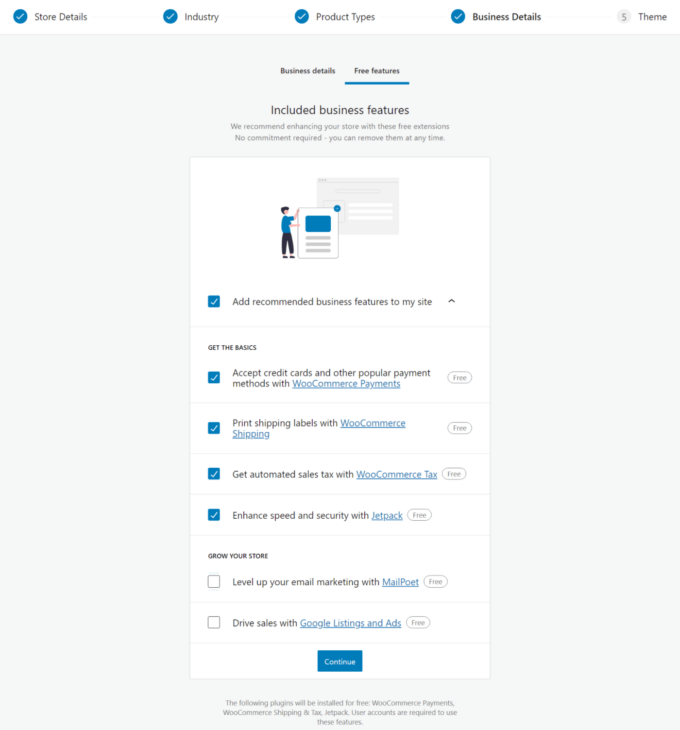
Theme
Finally, the setup wizard will prompt you to install a theme.
Just skip this section past clicking Proceed with my active theme — I'grand going to cover setting upward your WooCommerce theme in the next section:

If you've installed the "gratis business organisation features", you lot'll be prompted to connect your WooCommerce store to your WordPress.com account. If you don't have a WordPress.com account withal, yous'll also need to create one.
This account is gratuitous, just information technology'southward required to employ the dedicated services for payments, shipping, and taxes:

three. Choose a WooCommerce Theme
At this point, yous have a functioning store…but it probably doesn't expect like an eCommerce store.
To gear up that, you'll demand to install a purpose-built WooCommerce theme.
There are a few things to look for in a quality WooCommerce theme, including:
- Design – Evidently, y'all desire your theme to have a great blueprint that matches your desired aesthetic.
- Features – While yous'll add together most eCommerce features using plugins rather than your theme, you'll still want to expect for basic functionality, such as whether the theme provides a convenient product search choice or how its production filters wait.
- Performance – Your theme plays a large role in your store'south functioning and load times, then it's essential to choose a lightweight WooCommerce theme that won't slow downward your store.
We created our Botiga theme to do a expert job in all of those areas:
- It looks swell, with a modern, minimal design. You tin also choose from unlike importable demo sites to get the perfect look for your shop.
- It has all the features an online store needs from a theme, such as shopper-friendly product search, useful product filters, sales badges, and lots more than.
- Information technology's built to load fast. It weighs just 44.3 KB, minifies its own code, and achieves perfect performance scores out of the box.

For those reasons, I'yard going to apply Botiga for this tutorial. We'll stick with the complimentary version of the theme, merely there is also a premium version that adds more features if y'all want them.
Install the Botiga Theme
To go started with Botiga, go to Advent → Themes → Add New in your WordPress dashboard.
So, search for and install the free Botiga theme from WordPress.org.
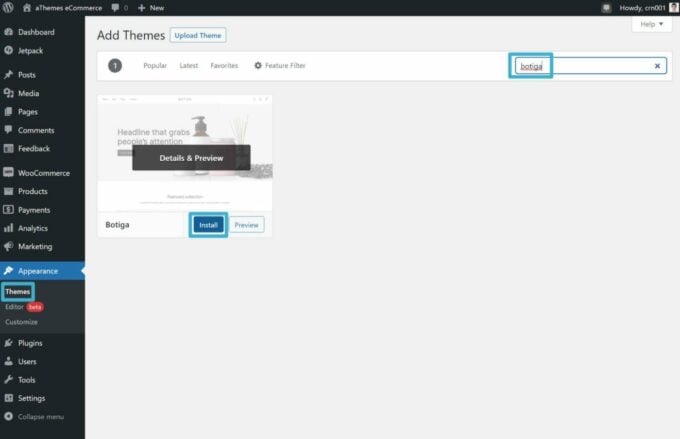
Import a Demo Site
Once yous activate the Botiga theme, you'll see a prompt to import one of Botiga'southward demo sites. This is optional, but it will have you upward and running with a stylish store from mean solar day 1.
If you want to import a demo site, click the Starter Sites push button:
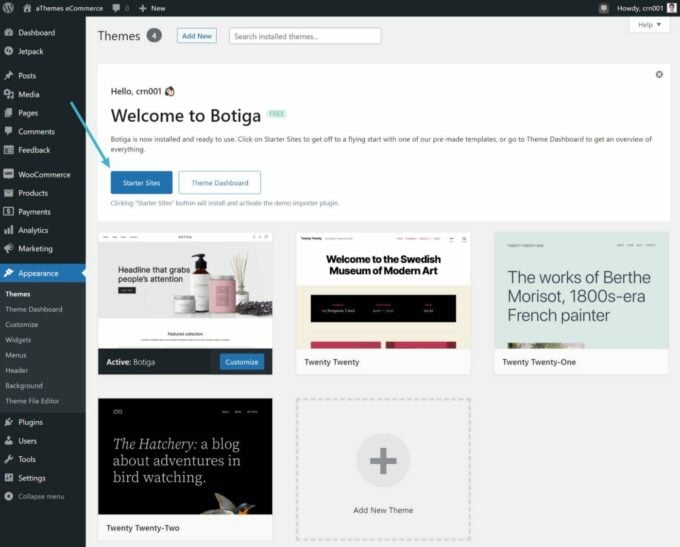
It volition automatically have yous to the starter sites area. Or, you tin go to Advent → Starter Sites.
To import a site, just hover over it and click the Import push button:

This volition launch a popup where you can choose exactly which content to import. Finalize your choices so click Import over again:

If y'all imported all of the demo content, your shop should at present look exactly similar the demo site that yous chose.
Customize the Demo Content
At present, y'all tin can make the content your ain.
To customize the theme styles, such as fonts and colors, you can go to Appearance → Customize.
And, to customize the individual pages, you can go to the Pages expanse and edit them only similar any other WordPress folio. All of Botiga'south demo content uses the native WordPress editor, which helps your store load as fast as possible.
4. Add together Your Products
Now that your store actually looks like an eCommerce store, you're ready to showtime calculation products.
At that place are a few other details you'll want to configure, but information technology's always motivating to see your first alive product, which is why I'm putting this department outset.
Note — if you imported a full Botiga demo site, Botiga volition import some instance products equally office of the process. You can employ these example products every bit inspiration and delete them when yous've added your own products.
To create a product, go to Products → Add New.
Here, fill out the product information. Pay special attention to the following areas:
- Title
- Short and long description
- Toll
- Product image
- Product categories
- Product tags
- Product type (available in the dropdown at the acme of the Product information box) — for example, whether it's a simple or a variable product (e.g. a t-shirt with multiple sizes)
You can as well use the tabs in the Production data box to configure other details such as inventory, dimensions/weight, linked products, and more than.
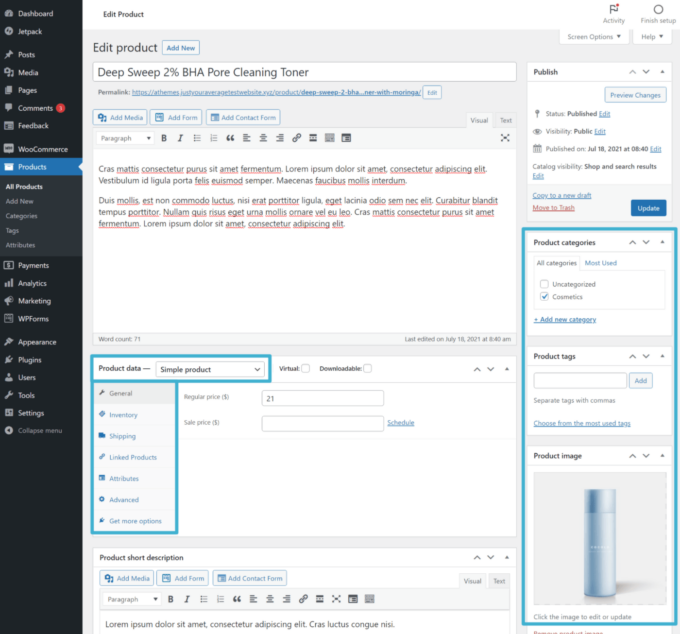
Don't worry almost messing anything up — you lot can always come back and edit these details after.
When you're happy with how everything looks, click the Update or Publish button only like yous would for a blog post. Equally presently as y'all do that, your product will be live on the frontend of your shop.
To add more products, all yous need to do is echo the process.
If you have hundreds or thousands of products, you can besides import your products via a CSV file, which can save some time.
5. Configure Other WooCommerce Settings
Now, it's time for the most boring part of this tutorial: setting up nitty-gritty details such equally payments, taxes, aircraft, etc.
While this tin can be a piddling tedious and time-consuming, it's essential to the functioning of your store, and then you can't just skip it.
How you'll do this actually depends on your store'south location and configuration, then I can't prove ane specific tutorial for every variation. However, I'll cover the highlights and then that you more often than not know what you demand to do.
A good starting point is to get to WooCommerce → Home in your dashboard, where you should run into a checklist:

Let's go through the key settings.
Payments
The easiest way to prepare payments is to use the official WooCommerce Payments service (which is based on Stripe). If y'all installed that as role of the setup process, all you lot need to do is click the Go paid with WooCommerce Payments selection in the checklist above to launch the setup wizard.
If you desire to configure a different gateway or utilise Stripe direct, y'all tin go to WooCommerce → Settings → Payments:
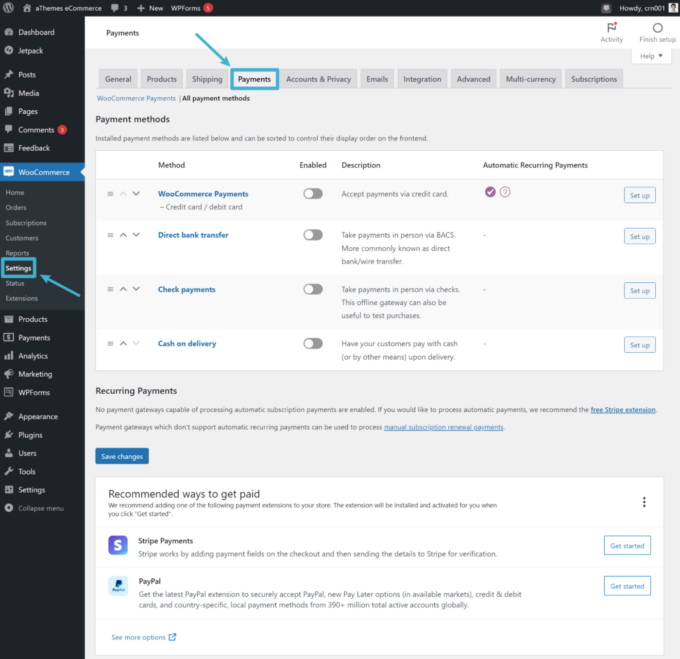
Y'all tin also install other 3rd-party payment gateway plugins if needed, which can exist helpful if in that location'southward a sure local payment gateway that you want to utilize.
Shipping Rates
There are two chief ways that virtually stores arroyo shipping on WooCommerce:
- Table-rate aircraft – You can enter a ready of aircraft rules. For instance, packages under i pound toll $5, packages between 1-5 pounds cost $10, and packages in a higher place 5 pounds cost $15.
- Real-time rates – You tin can calculate real-time shipping rates based on the actual dimensions of each order. You lot can integrate with USPS, UPS, FedEx, and others.
WooCommerce does have its ain built-in features for shipping rules. Nonetheless, you lot'll probably want a split shipping plugin because the built-in features don't back up tabular array-rate and existent-time rates.
If you want to explore the congenital-in shipping settings, you tin can go to WooCommerce → Settings → Shipping.
First, you'll define aircraft zones, which are groupings of one or more geographic areas. For example, you might accept one zone for the continental Usa:
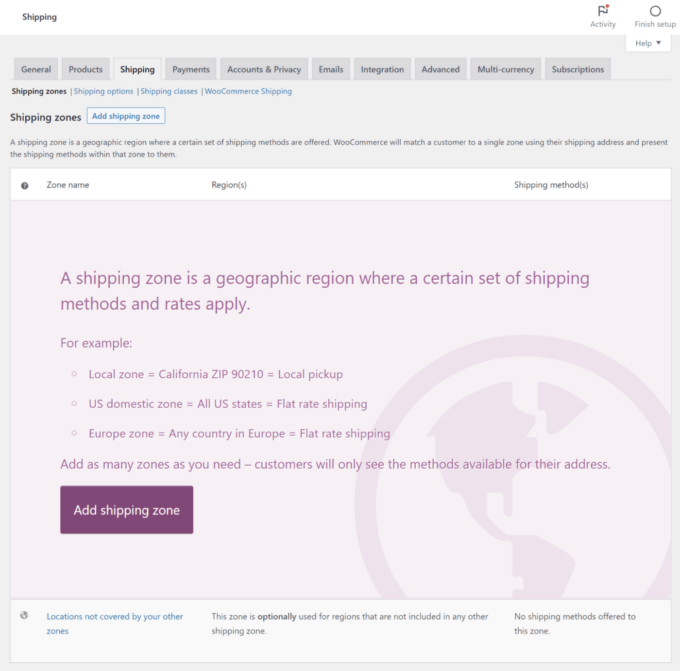
Once you've created a zone, you tin can add aircraft methods for that zone, which will just be visible to customers in one of the selected geographic areas.
There are three options:
- Flat rate
- Free shipping
- Local pickup

One time you add a method, y'all can enter its cost.
However, the built-in shipping characteristic doesn't let you change the price based on the weight/dimensions of a parcel, which is why you'll probably want either a table-rate shipping plugin or a real-fourth dimension rates plugin.
You lot can likewise consider a full order fulfillment service such equally ShipStation or TrackShip.
Taxes
The terminal major settings area to consider is your store's taxes. In many legal jurisdictions, you'll need to collect some blazon of sales revenue enhancement or VAT from your customers.
For simplicity, you'll probably desire to use a plugin here. The popular options are WooCommerce Tax and Avalara:
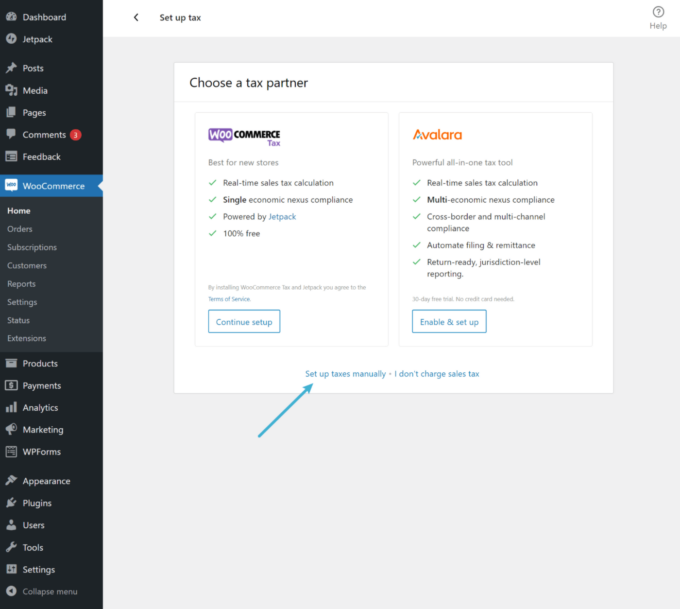
WooCommerce also has a manual tax selection, though information technology tries to hide it because information technology'southward complex. To enable manual taxes, you need to click the Prepare tax option and and so select the manual option.
One time y'all do that, you lot'll get a new settings expanse at WooCommerce → Settings → Taxes:

The fastest way to add together manual taxes would be to import a CSV of taxation rules. For instance, you lot can purchase a regularly updated CSV of Us tax rules for $29 from this site.
Other Settings
While payments, shipping, and taxes are some of the most of import settings for WooCommerce stores, they're far from the only things that you lot tin can control. So I highly recommend exploring the other options in the WooCommerce settings area.
For a lot of the settings, you lot'll be totally fine to leave them as the defaults.
However, you might discover some settings that you call up would exist amend to adjust.
For example, if you become to WooCommerce → Settings → Emails, y'all can customize the content of the emails that your store sends to customers and admins, such as the email that a shopper receives afterward they place an order:
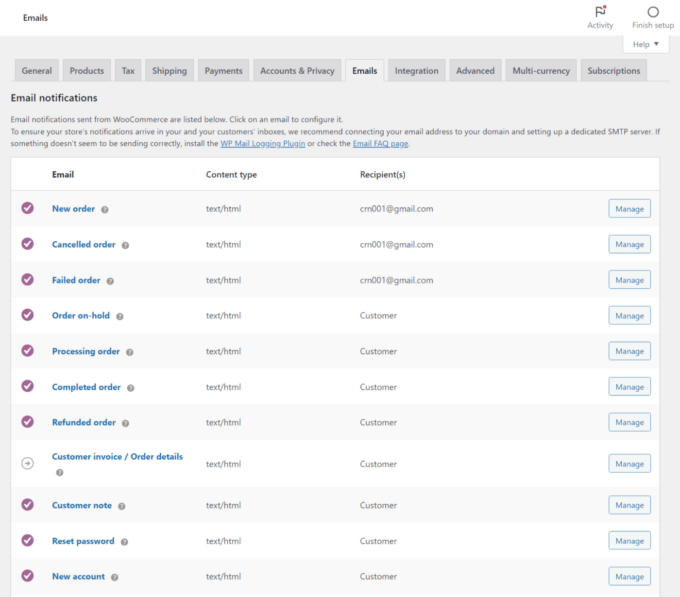
6. Install Plugins to Add More Features
One of the best things virtually using WooCommerce for WordPress eCommerce is the massive library of official and third-party plugins that you can apply to extend WooCommerce.
Your store volition absolutely rely on plugins to add key features. I don't call back at that place'south a single store that doesn't accept at to the lowest degree some WooCommerce plugins.
Notation that WooCommerce plugins are just regular WordPress plugins. I'm only calling them "WooCommerce plugins" for simplicity'southward sake, but y'all'll install them like whatsoever other WordPress plugin.
I already touched on plugins in the previous department. You'll generally desire to use plugins to prepare your shop's payment gateways, shipping rules, and tax rates.
However, you tin also discover thousands of other plugins to help with all areas of your store, including the post-obit:
- Marketing your store more effectively
- Adding helpful features for shoppers, such as wishlists or in-dashboard lodge tracking
- Improving your shop's admin processes to manage everything more effectively
- Getting more than command over your store's designs
- Etc.
I can't recommend a single gear up of plugins for all stores because in that location are and so many variables. The key particular hither is that you shouldn't be scared to use plugins to extend WooCommerce because all WooCommerce stores rely on plugins — typically dozens of them.
Then — how can you detect the best plugins for your WooCommerce store?
Well, starting time off, bank check out my collection of all the best WooCommerce plugins for different employ cases, including production search, filtering, wishlists, guild management, sales funnels, and other essential eCommerce features.
Beyond that, you can try browsing these popular plugin marketplaces:
- WordPress.org has thousands of gratis plugins tagged with WooCommerce.
- The official WooCommerce Extensions Store lists both gratis and premium plugins and includes official extensions also every bit those from third-party developers.
- CodeCanyon has over 1,400 premium plugins in the WooCommerce category.
I recommend starting the process past searching for the specific functionality that you need. Then, read the reviews and check the developer'south reputation, just as if you were installing whatever other WordPress plugin.
Because these plugins can touch the security and operation of your store, I recommend only installing plugins from reputable developers.
7. Optimize Your Store for Operation
At this betoken, y'all should have a fully functioning eCommerce shop that's ready to commencement receiving customers.
However, if you want your shop to be a success, it's essential that you lot optimize it to load quickly.
How quickly your shop loads will affect a range of different areas, including the following:
- Conversion rates
- Search engine rankings
- User feel
- Bounce rates
Don't worry — if you've followed this guide, y'all're already halfway to having a quick-loading store considering you're using a fast theme (Botiga) and performance-optimized hosting (Cloudways or your preferred host).
For the simplest way to comprehend the rest of the important optimization strategies, yous tin can use the WP Rocket plugin. While WP Rocket is a premium plugin, I recall it's worth the investment (my review) considering information technology offers the simplest fashion to speed upwardly your store.
To learn how to use it, you tin follow my tutorial on how to speed upwards WooCommerce with WP Rocket and Botiga. In that guide, I run actual speed tests after enabling the various optimization features so that you tin can run across what outcome they have on your site's functioning.
Create Your WordPress eCommerce Shop Today!
Congratulations! You just learned how to create an eCommerce website with WordPress, and I hope you were able to exercise it every bit painlessly as possible.
If y'all followed all the steps in this guide, you should now have a fully functioning store that's fix to start accepting orders from customers. Once yous start receiving orders, those details volition show up in the WooCommerce area of your WordPress dashboard, and you lot'll as well receive email notifications.
Or, if you're still in the planning stages of making a WordPress eCommerce store, you at to the lowest degree know what to await when you start building. You can come dorsum to this guide once y'all're ready to actually launch your store.
Exercise y'all still have whatever questions about how to make a WordPress eCommerce website? Allow usa know in the comments!
Searching for a free, professional person and lightweight WordPress theme? Come across Sydney!
View Theme
How To Use Wordpress For Website,
Source: https://athemes.com/tutorials/create-ecommerce-website-with-wordpress/
Posted by: kingrepasustem.blogspot.com


0 Response to "How To Use Wordpress For Website"
Post a Comment